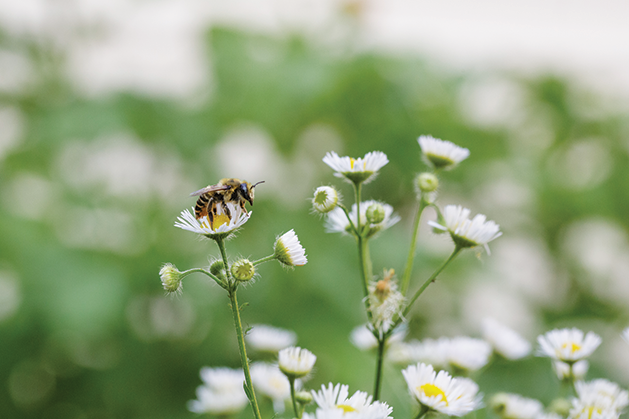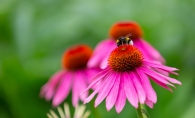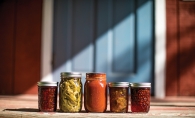
Wendy Froistad bought her Maple Grove home 34 years ago. For the first 15 years, she focused on her family and their day-to-day activities. The family’s yard was well-kept but unexceptional, a standard landscape in a nice suburban neighborhood. Then, after Froistad’s husband passed away in 2007, she planted a tree, a red maple, in his memory. Alongside this tree she planted a small, triangular garden, all the contents of which she ordered from a magazine. “I did their little map,” she says, explaining that she followed the planting directions provided by the company. But she enjoyed working in her yard, so she sought out additional plants.
The next spring, she expanded the garden to include plants and designs of her choosing. And, as the seasons changed, so did the garden, along with Froistad’s life. She met Bob Naydol in 2009, and he brought his own skills and interests to the yard. Naydol, an ecology major, implemented a native plants garden which has now gone through several expansions.
From these initial gardens, the couple’s yard has grown to include half a dozen other gardens, from standard vegetable and flower beds to unexpected plots, like a noxious plants area. The evolution of the yard is both complete and incomplete, as Naydol and Froistad celebrate the process and product of each respective garden.
In the center of the back yard is a mini-hosta garden; it’s a fitting placement as hostas are a favorite of Froistad’s. Naydol notes that one of the first things he noticed about her is that she really liked hostas. In addition to the mini-hosta garden, the property is home to every crowned champion hosta plant. “Since 1997 there has been a hosta of the year,” says Naydol, who can find and name of each of the 20 winners in various gardens around his yard.
While Froistad was initially a hosta fan, Naydol was drawn to native plants, so in 2010, he created a native garden to the side of the house that continues to evolve.
As they learn more and consider each respective garden, they make changes as needed. For example, the couple planned to add more shady plants this summer. Another addition to the native plants garden is a certified monarch waystation, which provides sustenance and shelter to migrating butterflies. The waystation is representative of the couple’s commitment to sustainability. Example B: a thistle garden which attracts bees. “Pollinators love this,” Naydol says. Bees are welcome to eat and then stay; he attached bee houses to the deck.
Perhaps the most unexpected addition is the noxious plants garden. Naydol describes this particular section as “clever and different,” and he notes that many people are amazed to learn which plants, like Lily of the Valley, are poisonous.
“There was a [similar] garden in England that I was reading about,” Naydol says, “and I thought, that’s kind of cool.” This garden is clearly marked and contained, and Froistad and Naydol enjoy surprising and educating guests with its presence.
Another unique but less menacing plot is the straw bale garden. Implemented in 2013, Froistad explains that the straw bale is intended to support a plant’s growth and sustainability. “You fertilize them and they heat up,” she says. “It’s supposed to make the root system stronger.” Froistad also refers to this garden as experimental. She and Naydol enjoy trying new and varied techniques, and they aren’t afraid to try something that might not work. While they have largely been successful at their various projects, they enjoy the process of the garden just as much, if not more than, the finished product. Case in point: the pond, which Naydol built himself in 2014. “It took me 3 months, on and off, to dig it,” he says. The pond is home to about 20 goldfish, which live inside during the winter.
Even relatively standard gardens enjoy a unique twist at the Froistad/Naydol residence. The square foot garden is a vegetable garden with different plants in each foot. A creative planting is what Froistad calls “ketchup and fries”—tomatoes and potatoes.
In addition to the tree planted in memory of her first husband, another particularly meaningful garden is dedicated to Froistad’s late mother, and it is grown from cuttings from her garden. “[Wendy] wanted something to memorialize her mother,” Naydol explains.
Froistad and Naydol want to share their gardens and their gardening tips with others. Last summer, their yard was included on the Maple Grove Garden Tour. They are also happy to offer advice to others who are interested in expanding gardens. “Research the plants and pay attention to zones,” suggests Naydol. He also supports buying locally, from neighborhood businesses and individuals.
The couple emphasizes taking time to enjoy a garden—both the process of creating one and its effect when completed. While their gardens require daily work—Naydol spends two hours a day watering—in addition to other projects and maintenance, the couple takes time to simply enjoy their backyard. “We sit outside almost every night,” Froistad says.
The couple also enjoys the work that goes into their gardens. They each gravitate toward tasks that they enjoy. Froistad weeds all of the gardens, while Naydol plans and carries out each project. This division of labor pleases them, and they enjoy working together.
The fun continues this summer, as Froistad and Naydol plan new landscaping projects for their front yard. While nearly all the current gardens are in the back and side yards, new planning will bring the couple’s creativity front and center. They’ll capitalize on what they have and can do themselves. And, of course, they plan to have a lot of fun, too.









